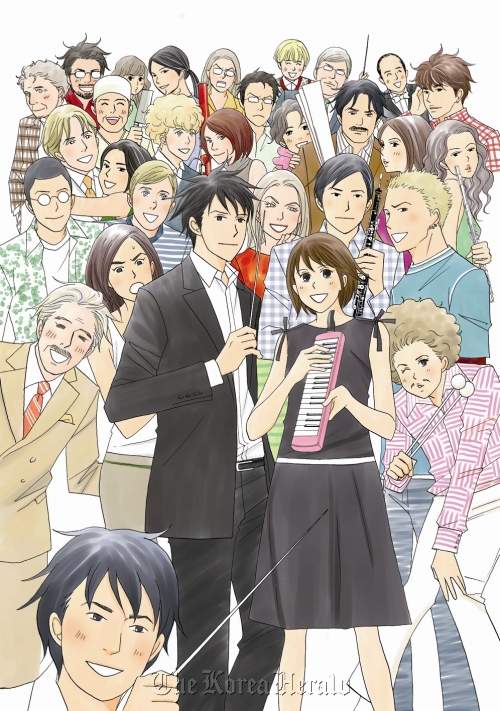
While manga is one of Japan’s most powerful mediums, with a huge influence on many industries including publication, film, games and even electronics, the art world has never quite embraced it as high art.
But now is perhaps the time to change that mindset, as Artsonje Center, a private art museum in Hwa-dong, central Seoul which usually presents contemporary conceptual art, has taken the bold step of opening its space for a special exhibition on Japanese comics.
Organized by SAMUSO and The Japan Foundation, the exhibition “Manga Realities: Exploring the Art of Japanese Comics Today” makes the case for why and how manga should be viewed as art.
“We pondered the question of how manga, which is born to be sold in the form of comic books in book stores, could be displayed at an exhibition. We also questioned the limit of manga; if it should stay as a commercial product and be bought and shared by many people, or become something more. We hope this exhibition will pave the way for more discussions on manga,” Takahashi Mizuki, curator of the exhibition, told the press Friday.
Manga’s sudden intrusion into a lofty art museum definitely seemed to have caught the media’s attention as the museum was unusually packed with journalists on the opening day. Setting aside all the lingering questions, the general response was that the show offers heart-fluttering memories for hardcore manga fans and an easy introduction for manga first-timers. Divided into nine sections, the show features some original illustrations from nine manga strips ― “Number Five,” “The World God Only Knows,” “Sugar Sugar Rune,” “BECK,” “Children of the Sea,” “Solanin,” “Five Minutes from the Station,” “Sennen Gaho” and “Nodame Cantabile.”
“Only the most representative manga that are translated into Korean and widely read here were selected for the show to better reach out to the public,” explained Mizuki.
Unlike in some exhibitions fe aturing comic strips which simply display the original illustrations, exhibition designer Toyoshima Hideki created something like a 3-D realization of the comics by adding whimsical props and installations that look like they just popped out of the comic books.
The section dedicated to Wakaki Tamiki’s “The World Only God Knows,” for example, is presented like a classroom with a chalkboard, a lecturn and 12 desks and chairs, just like it is illustrated in the comics. Brief introductions on the characters are written on the board in adorable handwriting.
Unlike in some exhibitions fe aturing comic strips which simply display the original illustrations, exhibition designer Toyoshima Hideki created something like a 3-D realization of the comics by adding whimsical props and installations that look like they just popped out of the comic books.
The section dedicated to Wakaki Tamiki’s “The World Only God Knows,” for example, is presented like a classroom with a chalkboard, a lecturn and 12 desks and chairs, just like it is illustrated in the comics. Brief introductions on the characters are written on the board in adorable handwriting.
The highlight and finale of the show is “Nodame Cantabile,” manga which was also made into a TV series and a movie that were extremely popular in Korea. Original illustrations and rough copies of the manga are exhibited behind a player piano that plays Beethoven’s Sonata Op. 13 No. 8, a significant musical number in the story.
The complete collection of the comics featured in the show are on display on the first floor of the museum. A guide book is distributed to visitors so even those who are not familiar with the original works are able to get a picture of what they are going to see before jumping into the sea of 3-D realized imaginations.
The exhibition runs through Feb. 13 at Artsonje Center in Hwa-dong, central Seoul. Tickets are 1,500 won for students and 3,000 won for adults. For more information, call (02) 733-8945 or visit www.artsonje.org/asc.
By Park Min-young (claire@heraldm.com)
The complete collection of the comics featured in the show are on display on the first floor of the museum. A guide book is distributed to visitors so even those who are not familiar with the original works are able to get a picture of what they are going to see before jumping into the sea of 3-D realized imaginations.
The exhibition runs through Feb. 13 at Artsonje Center in Hwa-dong, central Seoul. Tickets are 1,500 won for students and 3,000 won for adults. For more information, call (02) 733-8945 or visit www.artsonje.org/asc.
By Park Min-young (claire@heraldm.com)

1 comment:
The influence of manga comics is noticeable everywhere. As to its becoming a "fine art" well thats easy to see. There are pieces in museams here in minneapolis.
Post a Comment